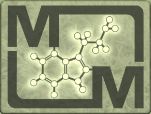 |
MAGISKA MOLEKYLERS WIKI |
Sceletium tortuosum
Namn: Kanna, Kougoed (även känd under namnet Mesembryanthemum tortuosum)
Innehåller: Mesembrin .m.m
Innehåll
[göm]Generell information
Kanna är en marktäckande suckulent från Sydafrika med vita blommor. Den används bl.a av Khoikhoi (tidigare kallade hottentotter) som enteogen. Traditionellt tuggas torkad kanna och salivet sväljs, men man kan även göra te, äta, sniffa och röka den för att få effekt.
Effekt och dosering
Ångestdämpande, sedativ, euforisk och stimulant.
En dos på 50 - 100 mg ger ett avslappnat och ångestdämpande rus.
Doser på 100 mg och mer ger ett mer euforiskt rus som följs av ett sedativt rus.
Ofermenterad kanna innehåller oxalsyra, vilket är skadligt.
Odling
Växten tycker om mycket sol och en relativt mager och luftig jord. Förökning kan ske med hjälp av frön eller sticklingar, om man utgår från sticklingar så ska de rotas relativt soligt och torrt, både i jord och luft (undvik plastpåse och liknande). Använd gärna rotningshormon (ej nödvändigt) och låt jorden torka ut helt mellan vattningarna (precis som för de rotade växterna).
Om man har frön så är en bra metod att lägga fröna i ett glas och hälla på ljummet vatten. Vattnet bör bytas ut ungefär en gång om dagen, då fröna sägs vara täckta av ett ämne som hämmar groningen vilket man då tvättar bort (detta har dom antagligen för att de bara ska gro under fuktiga perioder). När fröna gror så planteras de i en ganska mager luftig jord. Blanda gärna kaktusjord, blomjord och något för att puffa upp den som tex. perlit eller pimpsten. Om växten får en vedartad stjälk så är det en indikation på att jorden hålls för fuktig.
Om innehållet
Källa 1
- Mesembrin
- Mesembrinone
- Mesembranol (också kallad Mesembrinol)
- Tortuosamin
- 4’-O-demethylmesembrenol
- Sceletium Alkaloid A4
- Channain.
Källa: [1]
Källa 2
| “ | Sceletium tortuosum (L.) N.E.Br. was reported to contain 0.3% and 0.86% mesembrine in the leaves and stems, respectively (Watt and Breyer Brandwijk, 1932). Popelak and Lettenbauer (1968) reported that levels of alkaloids in 'kougoed' ranged from 1-1.5%, while mesembrine and mesembrenine levels were 0.7 and 0.2%, respectively. While this suggests that mesembrine may often be the most abundant alkaloid, it is important to note that the phenolic alkaloid constituents of the plant represent a highly complex, multi-component mixture (Jeffs et al., 1974) with as many as nine alkaloidal components (Popelak and Lettenbauer, 1968). Some of these are illustrated in Fig. 3, along with two synthetic analogues which have been patented by the Tanabe Seiyaku Company of Osaka, Japan. These had weak sedative effects on reserpine-induced central inhibition tests (Nabe, personal communication). Jeffs et al. (1974) presented a unified biogenetic scheme of the Sceletium alkaloids and distinguished three broad structural categories. One is typified by mesembrine, sceletenone, mesembrenone and mesembranol. A different skeletal type is typified by the dehydrojoubertiamine molecule (Fig. 3), first isolated from Sceletium joubertii by Arridt and Kruger (1970). Interestingly, these workers also reported the presence of hordenine in this species. Unidentified species of Delosperma have been reported to contain methyltryptarnine and dimethyltryptamine (Smith, 1977), although these would not be psychoactive orally without a monoamine oxidase inhibitor (Schultes, 1976; McKenna et al., 1984). Sceletium tortuosum was found to contain a third structural variant, Sceletium A4 and tortuosamine (Snyckers et al., 1971). Jeffs et al. (1970) found that 3-year-old plants of Sceletium strictum grown from seed yielded, from a dry cake weight of 151 g, some 4 g of alkaloid. Over half of this was demethylmesembrenol and demethylmesembranol, followed by mesembrenol, mesembrine, mesembranol, mesembrenone (Fig. 4). Curiously, on one occasion o-acetylmesembrenol proved to be the major alkaloid. In a later study (Jeffs et al., 1974) 3.5 kg dry weight Sceletium namaquense yielded 50 g of alkaloidal material. When 20g were subjected to column chromatography, formyltortuosamine and unidentified alkaloids predominated, followed by mesembranol, mesembrenone, mesembrine, unidentified alkaloids and mesembrenone, and Sceletium A4 alkaloid. — Smith et al. (1996)[2] |
” |
Externa länkar
Sceletium Wikipedia (en)
Sidan ändrades senast 28 december 2020 klockan 04.47.
Den här sidan har visats 12 779 gånger.











